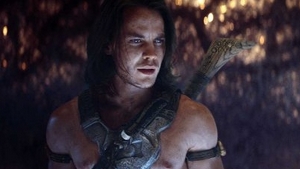
Today’s science fiction has a debt to Edgar Rice Burroughs. The man created what is widely considered one of the first alien worlds that leaved and breathed outside of our own realm. He gave them their own language, religion, culture, and feuds. And he did all of this with the first appearance of John Carter in 1912. Before Star Wars, before Avatar, before Star Trek, there was the Barsoom (what we call Mars) adventures and it was pulpy, light, fantastic fare. They inspired hundreds, if not thousands, of writers to dream big. Now, 100 years later, a big budget film version finally exists and I think it’s a worthy showcase of Mr. Burroughs work.
I say all of that because it is worth noting. You may walk into this film thinking it’s another hair brained 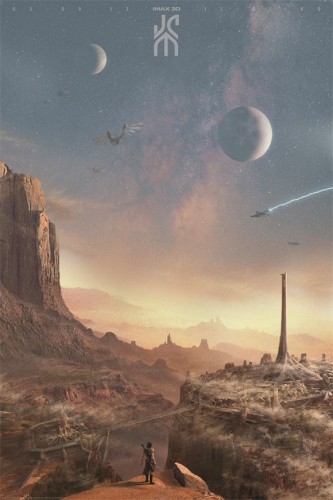 science fiction fantasy concocted out of thin air, but there is a lot of background as the opening sequence of John Carter sets up. There are essentially three factions on Barsoom. The first two are the human-like Heliumites and their rivals the Zodangans and both are known as “Red Men”. These two civilizations harness the power of light to fly vehicles and have a long-standing war. Then there are the Tharks: green, six-limbed, fifteen-foot tall aliens with tusks led by Tars Tarkas (Willem Dafoe). The Tharks want no part of the ongoing feud between the Heliumites and the Zodangans. The Jeddak (King) of Zodanga, Sab Than (Dominic West), has been given a mysterious and unstoppable weapon by a mystic race of beings and the Heliumites are desperate to save their race. Dejah Thoris (Lynn Collins), Princess of Helium, is the last remaining hope to bring peace by accepting the proposal of Sab Than to marry him. That is, until John Carter (Taylor Kitsch) arrives and changes everything.
science fiction fantasy concocted out of thin air, but there is a lot of background as the opening sequence of John Carter sets up. There are essentially three factions on Barsoom. The first two are the human-like Heliumites and their rivals the Zodangans and both are known as “Red Men”. These two civilizations harness the power of light to fly vehicles and have a long-standing war. Then there are the Tharks: green, six-limbed, fifteen-foot tall aliens with tusks led by Tars Tarkas (Willem Dafoe). The Tharks want no part of the ongoing feud between the Heliumites and the Zodangans. The Jeddak (King) of Zodanga, Sab Than (Dominic West), has been given a mysterious and unstoppable weapon by a mystic race of beings and the Heliumites are desperate to save their race. Dejah Thoris (Lynn Collins), Princess of Helium, is the last remaining hope to bring peace by accepting the proposal of Sab Than to marry him. That is, until John Carter (Taylor Kitsch) arrives and changes everything.
This is a lot to take in, but everything is given in bits and pieces. They setup the premise early, and then immediately give the backstory of John Carter. Carter is an Earthman from 1860s, who hails from Virginia, and was a former Captain in the Confederate army. Through much personal loss, he has lost the will to fight in wars and sets his sights on striking it rich and living a life without care. When he is tasked to come back into the ongoing war with the Native Americans, he attempts escape and winds up in a mysterious cave. Through a form of astral projection, he ends up transported to Barsoom where the lesser gravity gives him the ability to leap incredible distances and enables super-human strength.
In lesser hands, this transition would have felt clunky and jarring. That’s why it’s thankful that Andrew Stanton, the writer and director of Pixar classics Finding Nemo and WALL-E, is at the helm making his live-action debut. Having read the books as a boy, Stanton remembered the stories fondly but when setting out to co-write this adaptation, he went with his memory on first draft. This means that while a lot of things change, a lot remains the same and the heart and soul remains. Fans of Burroughs’ work can look forward to a lot of great moments right out of the novel, including the lovable Woola, a six-limbed, super-fast dog creature that has a mouth full of razor-sharp teeth and follows Carter as a protector. Those that are new should brace themselves for a slew of new words, terms, and hierarchies. For some, it will be bewildering without a handout. That makes it even more important that they break up the exposition with the numerous action sequences and discoveries, but I still feel for those unacquainted with Burroughs’ work.
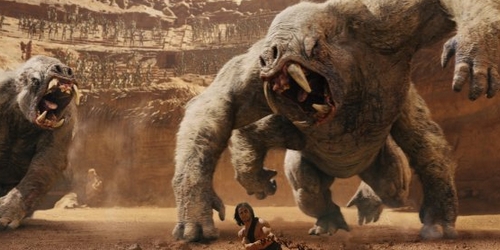
In lesser hands, this transition would have felt clunky and jarring. That’s why it’s thankful that Andrew Stanton, the writer and director of Pixar classics Finding Nemo and WALL-E, is at the helm making his live-action debut. Having read the books as a boy, Stanton remembered the stories fondly but when setting out to co-write this adaptation, he went with his memory on first draft. This means that while a lot of things change, a lot remains the same and the heart and soul remains. Fans of Burroughs’ work can look forward to a lot of great moments right out of the novel, including the lovable Woola, a six-limbed, super-fast dog creature that has a mouth full of razor-sharp teeth and follows Carter as a protector. Those that are new should brace themselves for a slew of new words, terms, and hierarchies. For some, it will be bewildering without a handout. That makes it even more important that they break up the exposition with the numerous action sequences and discoveries, but I still feel for those unacquainted with Burroughs’ work.
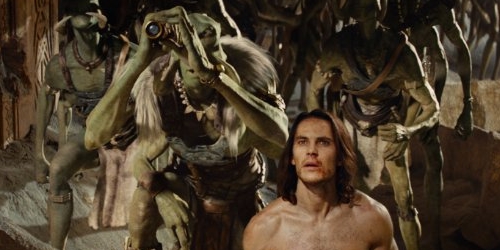
Within the world of Barsoom are incredible vistas and landscapes, and they are beautifully rendered or captured. Much of the film was shot in Utah and the blend of practical and digital effects in the background help capture the essence of a world that lives and breathes. Some of the setpieces are enormous, including battles between the Red Martians’ flying ships. Sword fights were often center stage in the Barsoom novels, and that’s one thing that seemed to truly be missing here. They exist, but their impact is considerably less than expected. Meanwhile, the story itself is of Carter’s exploration of the world of Barsoom and his journey at finding a place worth fighting for. He is flawed but honorable. So many of the cliches exist but are also broken in many ways. Tars Tarkas, the leader of the Tharks that Carter encounters, has compassion, something rarely seen among his race and it is a danger to his leadership. There is no room for emotion in their savage race, and so he must hide it. Dejah, meanwhile, is incredibly beautiful but is headstrong, a scientist in her own right, and formidable with a sword. In many ways, all three are equals, though their backgrounds and stature vary widely. Carter and Thoris in particular are not thrown into a love story that falls in easily. He is wary of his affection, and she doesn’t know whether he is a liar or simply a fool, with his talks about coming from a world filled with water known as Earth.
G-S-T RULING:
Those tweaks are pulled off masterfully by the actors, and indeed the entire cast is deserved of praise. Kitsch and Collins give their characters dimension and Dafoe soars as the voice of Tars Tarkas. The motion capture is also something to behold as the Tharks are rendered in glorious detail, though they take a while to get used to seeing. Their green skin is offset by the dark red hues of the setting. Clocking in at 132 minutes, this is an origin story that feels fully realized and epic. Yes, there is setup for more—a trilogy has been mentioned based on Burroughs’ first three novels—but there is also an end that satisfies. John Carter strives to be a serious adventure that doesn’t laugh at its own jokes. When there is humor, it is intentional, and the laughs are not forced but earned. Simply watching Carter learn how to walk on Mars is a clear sign that there is room for humor without being overdone. That is just part of the balancing act within John Carter, and I certainly feel Stanton and company will look back with pride at their achievement and I hope I can return to Barsoom for more.
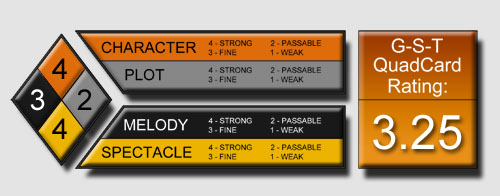


2 Comments
Markus Welby
There were some things to like about JC, but ultimately this failed to knock it out of the park for me. The pacing was off, and I feel this world might be better served as a TV series. Pandora was much more visually stimulating, but I did find that Taylor was a more likable hero than Worthington.
Andrew Crump
I would have liked to have seen the Burroughs character bookending the movie cut out (even though that conceit is actually used in the series at one point), along with the Therns. Stanton clearly wants the Therns to be the heavies in the other films, but I think mentioning them in passing a’la the temple scene would have been enough for us to go back to them in part 2 without much trouble. Here, they– along with the Burroughs framing device– just over-complicate an already packed movie. Relieved of those burdens I think this would have improved dramatically.
But I still really liked it anyways, because the stuff that works is so much stronger than the stuff that doesn’t. Collins is outstanding as Dejah Thoris, while Stanton’s work behind the camera is compelling and uniformly strong. His eye for action in particular makes John Carter sing, though he does the world-building dance pretty much perfectly apart from the extraneous presence of the Therns. The fight between John and the horde of Tharks is flat-out incredible. Stanton should be really proud of that one. And the entire film looks great from start to finish, with maybe a handful of wobbly FX that get drowned out by otherwise consistently good stuff.
What I don’t get is how badly this was mis-marketed. I mean, seriously– why present this as an Avatar or Star Wars knock-off instead of as the story that helped spawn those two films?